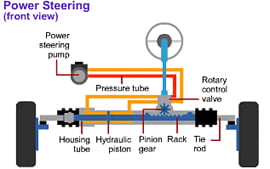We are back with yet another theme from automobile engineering. It always helps to have knowledge about your vehicle. People are getting more and more interested in knowing a lot about their vehicles. As a result, we bring to you some common but technical themes related to your car in a simple to understand language so that you don’t get bored with just some random technical terms. Before we dive into today’s topic though, make sure to check out Car Blog India for all the latest happenings from the world of the automobile industry and Automobile Technology Section to read fascinating technology related to automobiles in a simple language.
Also read: All you need to know about AWD and 4WD – What is a Differential?

Steering Mechanism- Principle and Working
Steerings are one of the most essential parts of the vehicle without which no automobiles can exist. It is because of the ability of the wheels to turn according to the driver’s input, that the movement of the vehicle is possible at all. Also, to negotiate the curves and change directions with a car, steering is the tool at the driver’s disposal. So, one can only turn the car if the wheels turn with the steering input. The components of any steering system generally include Rack and Pinion gear assembly, steering shaft, ball bearing joint, tie rods. The working of all these components will be explained in the next paragraph. So, what exactly happens when you turn the steering wheel?
Also read: How do ABS, EBD, Brake Assist, Hill-Hold Assist & Traction Control work?
Well, the steering wheel is connected to the steering column which holds the steering shaft within. This shaft is connected to pinion gear at the end with the help of a ball bearing joint which helps in translating the movement of the steering wheel to the pinion. THe pinion gear is connected to the rack and form the Rack and Pinion Gear Assembly. The rack is the gear that has only translatory motion and can move only sideways. The ends of the rack are connected to the Tie Rods, which are, in turn, connected to the wheel hub. This is what actually moves the tyres or the wheels in any given direction. So, this is the overall process that converts the drivers’ manual efforts to the wheels.
Also read: Camshafts and Valves – Working and Classification!
Hydraulic Power Steering
From the earlier times, it was observed that moving heavy vehicles with sheer human force was too much effort for the driver. Hence, some kind of assist was required. As with all the other automobile technologies, some components were designed to aid the drive and reduce human efforts. The first such thing was incorporating a hydraulic system into the steering mechanism in a way that the steering effort of the driver could be reduced significantly. This gave birth to a hydraulic assembly which included a hydraulic pump, reservoir, hydraulic piping, hydraulic working fluid, double-acting cylinder and rotational valve to name a few. These were the main component of that hydraulic system. The hydraulic pump was connected to the engine of the car with the help of belts.
Also read: What is EGR (Exhaust Gas Recirculation) – Working, Principle & Advantages!
When the driver turned the steering wheel to either the left or the right side, the hydraulic system got activated by opening the rotational valve and allowing the fluid to enter the cylinder. The cylinder would move in the desired direction and in turn, make the rack move with it as well. This means that the force required by the driver was reduced significantly as the hydraulic force complemented it. This took off a lot of pressure from the driver and the steering process became easier for the drivers even when they were driving a heavy vehicle. Hydraulic power steering has been used in vehicles for a long time now. It is also important to mention here, that if this system fails, the string wheels will not get blocked. The driving will still be able to steer the car, albeit with a bit more effort.
Also read: What is Air Suspension – What are Stiff and Soft Springs?
Electric Power Steering
As the name suggests, electric power steering makes use of the electric aid to ease the effort of the driver. In this case, an electric motor is connected to the steering assembly and the driver’s input is sent to the ECU (Electric Control Unit) of the vehicle along with other inputs like the torque by the driver, steering angles, speed of the steering wheel, etc and ECU further sends a signal to the electric motor to supply the required torque to the steering assembly. The rest of the system works just like the regular rack and pinion gear assembly. The effort of the driver is converted to an electric signal and ECU process that information and sends out the desired output signal to the components. Like in the case of hydraulic power steering, here also, if this system fails, the entire process will turn manual but the steering wheel will not get locked.
Also read: What are Intercoolers – Types and Functions!
Electrohydraulic Power Steering
Some cars which are luxury or performance-oriented, have a combination of the two systems. The point of such a system is to offer the best of both worlds. In the case of an electric power steering, the driver is almost disconnected from the road completely and people complain about having no steering feel at all. At the end of the day, to have the vibrations or the feel of the road coming in through the steering wheel can be useful information for the driver. In parking positions, you don’t want your steering to be heavy and hence, electric power steering makes sure that that doesn’t happen.
Also read: What is Engine Braking – How does Cooling System work?
On the other hand, at higher speeds the driver wants the steering to be a bit heavy to inspire confidence and ensure high-speed stability. You don’t want the steering to be very light and shaking. Here, the hydraulic aspect dominates and keeps the driver engage with just little aid. Hence, the driver is able to have more control and feel of the road. Here, the driver is not completely disconnected from the road as with electric power steering.
Also read: What are Engine Remapping, Tuning & Calibration – Should you remap your car?
Image Source – CarTalk


